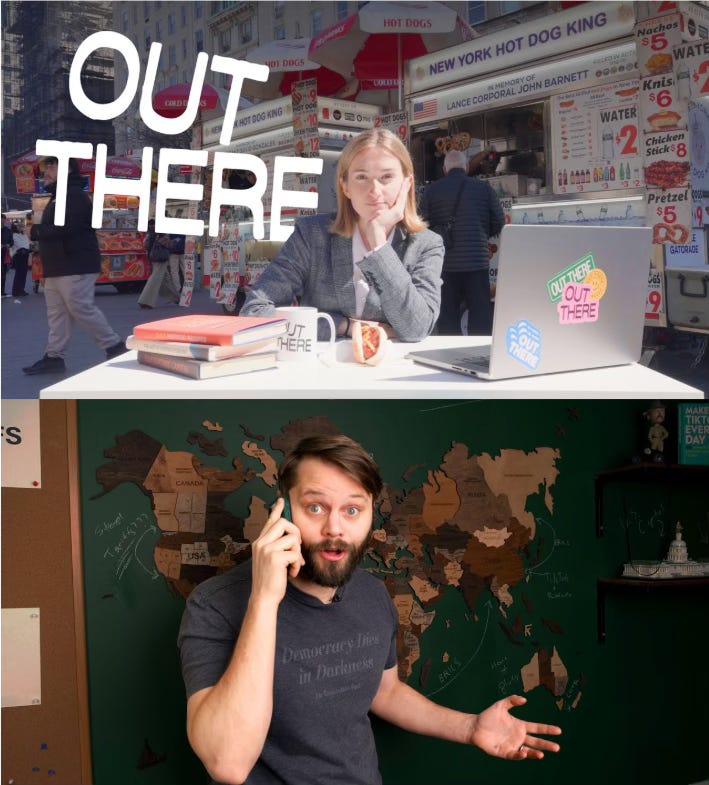Employees, Talent and Creators Are Merging
What happens when your top creator is also your employee, and their talent agent is coming to the next HR meeting?

The best social media employees always create the most tension inside a company.
The same people who really understand social media are always walking — and often crossing — the fine line between brand promotion and self-promotion. You find that your social media channels are thriving, but the whole company is squirming.
I’ve lived in this dynamic since social media became a thing, and this Rachel Karten video made me realize that this powder keg is about to explode across the landscape of creators, social media employees and athletes.
Karten first highlights Morning Brew’s Macy Gilliam, the longtime face and innovator of the company’s video strategy, who apparently doubled her salary while gaining freedom to promote her own projects.
Interestingly, an article in Publish Press about the deal frames Gilliam not as a journalist but as a comedian, who is represented by a talent agency. How many people imagine their social media manager bringing a talent agent to a HR meeting?
How many people imagine their social media manager bringing a talent agent to a HR meeting?
Gilliam is starting a new show, and “Morning Brew will own the show IP, but Gilliam can promote her personal social channels on Morning Brew’s accounts and spend time with her producer making personal content.”
Most media companies have strict boundaries — your time belongs to them, and monetizing your personal brand on the clock is a no-go.
In fact, many media companies simply say that employees can’t maintain any social media side hustles because it’s too messy. I get it. Imagine that a media company sends an employee to cover an event, secures access that an individual oftentimes can’t and pays for expenses and labor. Then the employee splits content between personal and brand channels? Or posts to their personal Instagram and shares that content to brand channels? (Actually you don’t have to imagine that; it happens all the time.)
Or thornier — can an employee with successful social channels also make creator deals? There’s an obvious conflict of interest, and at some level, the money for creator payments comes out of advertising budget that could have gone to the media brand.
And yet… the employees who constantly push these boundaries are the same ones who will make your brand succeed.
Then there’s the Washington Post co-producing a YouTube show with its TikTok star Dave Jorgenson, on a non-WaPo-branded channel. Who owns the ads? Who gets the revenue? What is WaPo’s incentive here?
Or recall the January breakup between Barstool Sports and podcaster Grace O’Malley. Portnoy responded to O’Malley’s public complaints with a long video that outlined her contract details. Long story short: She was making a base salary, plus 70% of sales that Barstool generated on her personal channels.
And yet… the employees who constantly push these boundaries are the same ones who will make your brand succeed.
Meanwhile, as Matt Trappe points out over at A Matter of Brand, the outdoor industry is pulling athletes into more employee-like roles. Anton Krupika recently signed a deal with La Sportiva that includes community management and product development roles. Same process; Opposite direction.
All of these anecdotes point in the same direction: We’re entering a new era in which the lines between creator and employee, athlete and talent get very blurry.
Personality-driven social media will create major headaches.
Every year social media increasingly favors personal channels, forcing brands to lean ever more into personality-driven content. Simultaneously, creators and athletes are becoming ever savvier at turning their communities into business opportunities.
There’s a huge opportunity to maximize these opportunities, or to drive the whole content strategy headfirst into a ditch.
Employees are more like talent, talent now provides services akin to what an employee once did, and creators who straddle the lines do all of these things. And any of them could be building side-hustles around their social channels. We’ll see conflicts of interest, employees essentially competing with their employers for audience and some very muddled relationships.
There’s a huge opportunity to maximize these opportunities, or to drive the whole content strategy headfirst into a ditch.
Co-Created Content Production is Coming.
Brand-sponsored, athlete-created films have long been a staple of action sports, and there are countless formulas for producing and financing them. But I’m interested in this Dave Jorgenson/WaPo model – What does a YouTube show co-owned by a brand and an athlete-creator look like? What happens when there’s a spin-off? What if a brand and athlete build a TikTok show together, and the athlete leaves for a new sponsor? How does brand integration and approval work in a co-owned project?
Creators are effective as producers, distributors and experts in community-building, but the path forward here is not clear yet.
Can You Build Brand-Creator Content IP?
This brings up an interesting question – Can a non-media brand actually create IP value around co-owned content? Likely yes. If YETI Presents, Faction Collective or Rapha FIlms represent the peak of big-budget, longer-format brand filmmaking, what does the concept look like as a short-form series on an athlete’s social media channels? Heck, Ted Lasso was originally an ad, and the Geico caveman commercials turned into a TV show.
We Need New Teams to Manage This.
Every example at the top of this article opens the gates to a convoluted jungle of content rights, rev-sharing and ownership questions. Too few media companies or consumer brands have the people to actually solve for this. If your marketing team is built to smash paid-media ROAS and affiliate deals, don’t expect them to also navigate these waters as a side gig. We’re leaping into the unknown, creating social-first content with a potentially confusing mixture of ownership, distribution and revenue-sharing. Take it seriously, or the tensions inside the company will create destruction, not innovation.



